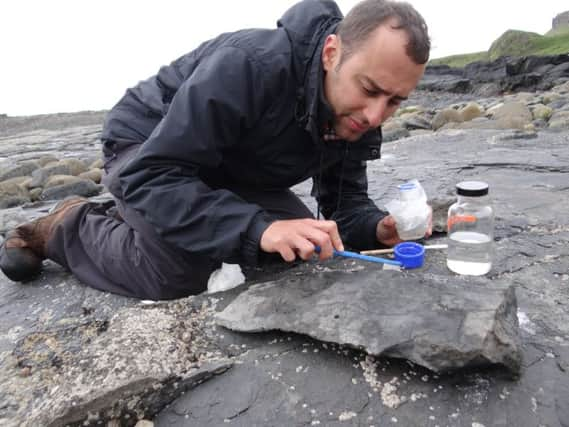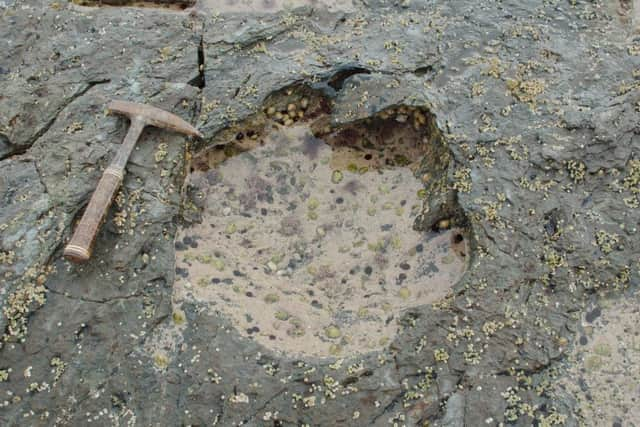Finding a very real Jurassic Park on the Isle of Skye


Five years ago, I moved to Scotland from the United States so I could study dinosaurs.
It was an odd move for a palaeontologist like me. Scotland is many wonderful things, but it is no dinosaur hotspot. While thousands of fossil skeletons have been found in the badlands in the western reaches of my home country, people didn’t even realise that dinosaurs once lived in Scotland until a single footprint turned up on the Isle of Skye in the 1980s, on a chunk of limestone that had tumbled off a cliff.
Advertisement
Hide AdAdvertisement
Hide AdBut, when the University of Edinburgh – perpetually in those top lists of the world’s greatest universities – offers a faculty job, only a fool would say no. So I raced to finish up my doctorate in New York, convinced my English-born wife that she could make it north of the border, and we moved into a tenement-building flat in a city that I only really knew through watching Trainspotting.


As it turned out, coming to Scotland was the greatest break in my life. I was given the chance to build a new laboratory focusing on the evolution of long-extinct creatures, recruit a group of ace students, and establish a fieldwork programme that travels around the world digging up dinosaurs. Through our adventures – from the sun-scarred scablands of New Mexico to those midge-clouded cliff falls of the Isle of Skye – we’ve learned a lot about dinosaurs and the world they lived in, during that long stretch of time from about 230 until 66 million years ago, long before humans entered the scene.
It’s been such a thrill that I’ve made it into a book. It’s called The Rise and Fall of the Dinosaurs, and it’s out now. My book is for adults, not children. By that, I don’t mean it’s risqué (although there are a few scenes of dinosaur hunters toasting their discoveries with adult beverages). Rather, if you look on Amazon there are thousands of dinosaur books for kids: picture books, encyclopaedias, coffee table tomes with flamboyant CGI images. There are very few books written for an older audience, which is a shame because dinosaurs have quite the story to tell.
The dinosaurs were an empire. Their history reads like fiction, but it really happened. To me, it is one of the greatest narratives in the history of our planet. And it is this story that I tell in my book: where the dinosaurs came from, how they rose up to dominance, how some of them became so colossal they shook the earth as they walked, how others grew feathers and turned into birds, and how the rest of them suddenly went extinct because of one very bad day.
Now, I don’t want to give away the whole story, but I’ll provide a few spoilers.
Dinosaurs started humble, as gangly cat-sized critters that raced around on four legs, as part of a wave of new species populating the Earth after millions of years of supervolcano eruptions nearly snuffed out the whole planet 250 million years ago. These first dinosaurs didn’t have it easy: they lived in a hothouse world, during what we call the Triassic Period, when all land was globbed together into one giant supercontinent called Pangea. Car-sized amphibians and jeep-sized crocodile cousins ruled Pangea, and for some 30 million years they kept the dinosaurs in the shadows. But then, the supercontinent began to break, lava welled up through the cracks, supervolcanoes erupted again, and the dinosaurs somehow survived while the jumbo salamanders and crocs mostly died.
As the volcanoes went silent, a new world dawned: the Jurassic Period. Dinosaurs now had an open frontier, and they conquered it. They spread around the world and diversified like a virus, evolving into the characteristic meat-eating, plate-backed, armour-covered, and giant long-necked species that fuel the imaginations of children the world over. They found their way into every type of environment on land, from the jungles and deserts to the smallest islands and even the north and south poles. Some of these dinosaurs became brutes the size of Boeing 737s, while others got small, lengthened their arms, developed feathers and then wings, and started flapping around – the ancestors of today’s birds. As the Jurassic transitioned into the Cretaceous Period, the Age of Dinosaurs continued, and the most famous dinosaur of all seized control: Tyrannosaurus rex, the 13-metre-long, 7-ton, bus-sized demon that could literally crush the bones of its prey.
T. rex was there when it all changed. It witnessed the worst day in the history of Earth, a few hours of destruction that undid more than 150 million years of evolution. I don’t have nearly the word count here to go into the hyperbole of that day, but it started with the impact of a six-mile wide asteroid, which triggered a chain reaction of wildfires and earthquakes and global dust that killed off all dinosaurs except for a few birds. In doing so, it provided a lesson for humanity: if it could happen to the dinosaurs, after their millions of years of dominance, could it also happen to us?
Advertisement
Hide AdAdvertisement
Hide AdWhen it comes down to it, lessons like these make dinosaurs relevant. Sure, dinosaurs are awesome. It’s an indescribable feeling to stand underneath the skeleton of a dinosaur – say, the T. rex at the National Museum of Scotland in Edinburgh – and imagine them as real living, breathing creatures that lived so long ago. But dinosaurs are more than monsters, more than a childhood fascination. They tell us how evolution works, how the Earth has changed over time, and how real animals have responded to real moments of climate and environmental change. The dinosaurs are the story, and their fossils are the clues.
This is why palaeontologists like myself will go to whatever lengths we can to find fossils – braving cold, heat, humidity, dust, snakes, bugs, and sometimes even warzones. One of the great perks of my job is that I get to act as detective, scouring the world for dinosaurs. And one of the great thrills of the last five years in Scotland is that I’ve been able to discover dinosaurs right here in my new home.
A few weeks ago, my team announced our latest discovery: a tracksite on the Isle of Skye, with about 50 footprints and handprints left by two types of dinosaurs: a long-necked plant-eater that was the size of a few elephants, and a fast-running carnivore that was a primitive cousin of T. rex. We’ve made many other finds on Skye as well: hundreds of long-necked dinosaur tracks left in an ancient lagoon near Duntulm Castle, the bones and teeth of dinosaurs and the crocodiles they lived alongside, and even the remains of boat-sized reptiles that ruled the waves while the dinosaurs thundered across the land.
All of these creatures lived about 170 million years ago, during the middle part of the Jurassic Period, when dinosaurs were putting their final flourishes on their rise to dominance. Believe it or not, Scotland has one of the best records of fossils of this age, from anywhere in the world. So yes, Scotland indeed IS a dinosaur hotspot, and the new discoveries we are making here are helping us tell the story of the rise and fall of the dinosaur empire.
Dr Steve Brusatte is Reader in Vertebrate Palaeontology on the faculty of School of GeoSciences at the University of Edinburgh. His new book The Rise and Fall of the Dinosaurs is published by Macmillan in hardback, £20